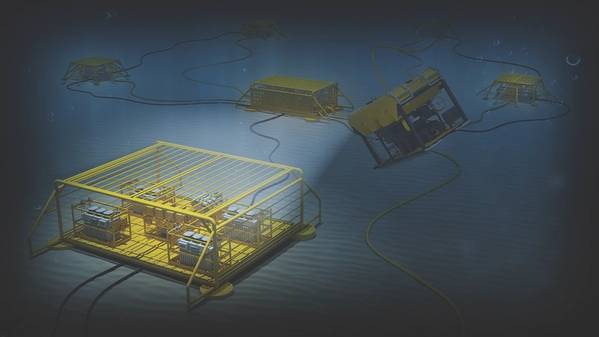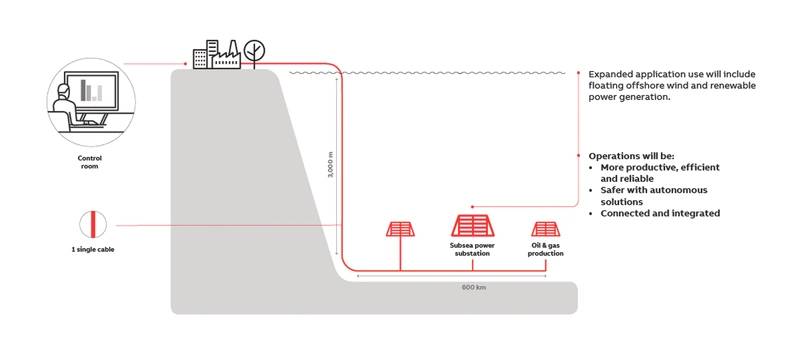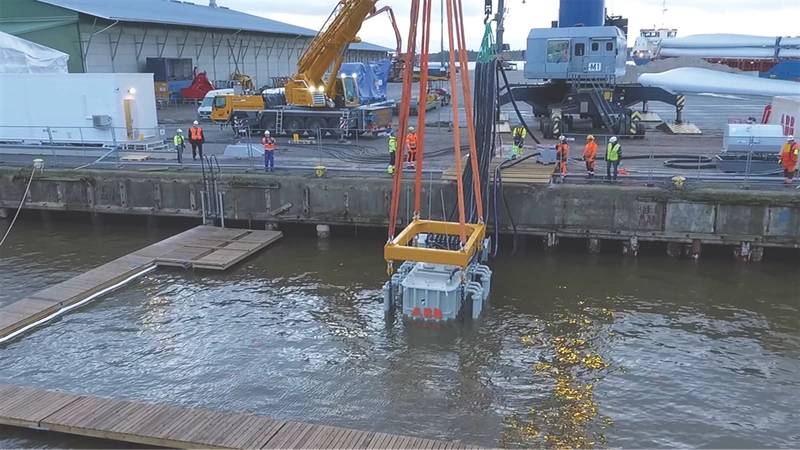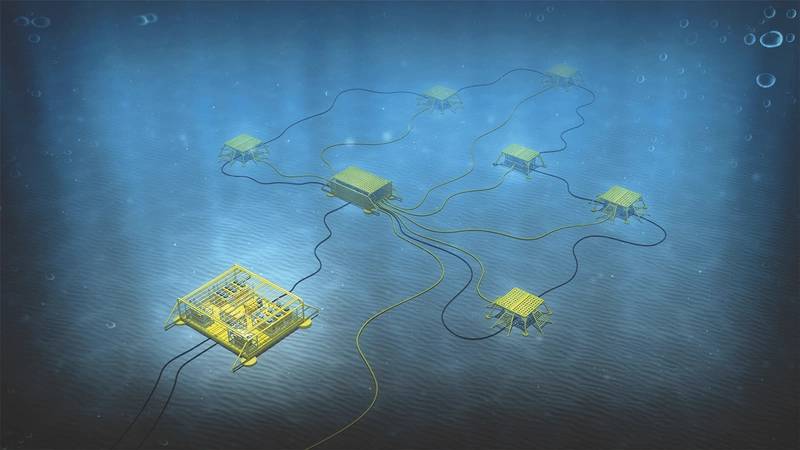
In November 2019 ABB announced the commercial availability of its new subsea power distribution and conversion technology system. Jointly developed with Equinor, Chevron and Total, the tech aims to see the majority of the world’s offshore hydrocarbon resources harvested via the use of subsea electrification.
Environmental regulatory pressures and market realities have conspired to help offshore oil and gas operators conceive a clearer vision for a safer, more energy-efficient, cost-effective and environmentally benign future, both for its mature basins and new, remote, deep water frontiers alike.
To help the industry achieve these goals, ABB, in a $100 million research, design and development joint industry project (JIP) initiated in 2013 with partners Equinor, Chevron and Total, has designed, developed and tested a new subsea medium-voltage power distribution and conversion system that enables all production operations to be moved to the seabed, making a critical last step to realizing the dream of a true subsea facility.
In November 2019 ABB announced the commercial availability of the new subsea power system having completed a 3,000-hour shallow-water test at a sheltered harbor in Vaasa, Finland, that it says demonstrated the validity of the technology. This means that the majority of the world’s offshore hydrocarbon resources can be harvested through the use of subsea electrification.
Subsea vs. topside
Conventional topside offshore hydrocarbon production systems are typically housed on large, manned floating or fixed structures that are expensive to operate and where space for housing power and control equipment is often constrained.
In addition, costly dedicated power and electro-hydraulic umbilical cables are required for each power user on the seabed, creating a topology that is expensive, hard to adapt to new configurations, and restricted in its ability to support digitalization initiatives due to limited bandwidth.
Most of today’s structures use gas turbines for local power generation, with consequent emissions impacting the environment. Other disadvantages are the exposure of humans to risk and the requirement for constant maintenance and logistics support in addition to the costs of building and operating these energy-inefficient units.
To overcome these problems, over the years oil and gas companies have attempted to install production infrastructure on the seabed in order to benefit from greater production efficiency and greatly reduced environmental impact. However, early subsea power distribution systems suffered from the drawback of limited tie-back distances, which were restricted to less than 150 kilometers (km).
In contrast, the results of the JIP between ABB and its partners show that, for the first time worldwide, energy companies will be able to access a reliable supply of up to 100 megawatts of power over distances of up to 600 km and down to depths of 3,000 meters, where ambient pressures are in excess of 300 atmospheres. Power can be supplied through a single cable that can be used for up to 30 years, thereby making oil and gas production in distant and deep ocean environments a reality.
“This milestone marks an outstanding achievement and is the culmination point of an inspirational technology development achieved through tremendous dedication, expertise and perseverance. It is the result of intensive collaboration by over 200 scientists from ABB, Equinor, Total and Chevron in a multi-year joint effort,” said Dr. Peter Terwiesch, President of the Industrial Automation business of ABB.
 (Image: ABB)
(Image: ABB)
Electrification of subsea components
The research and development work undertaken in the JIP has resulted in subsea components and systems from actuators to pumps and compressors increasingly being electrified, thereby helping to increase system availability and control and reduce component size, cost and energy intensity, as well as remove personnel from a high-risk environment through the use of remote and unmanned operations. ABB says that by introducing technology that can distribute subsea power over long distances and down to great depths to reach subsea production systems, the full possibilities of this technology can be realized and adds that, based on a specific development case, the new system could offer capital expenditure savings of more than $500 million by linking eight power-consuming units such as pumps and compressors through a single cable over a distance of 200 km from other infrastructure.
In addition, the supply of power to such units on the seabed can significantly reduce power consumption, resulting in substantial energy savings and much lower carbon emissions compared with using shore-based systems. The technology can be driven by any power source, including wind and hydro power. A further benefit of the subsea technology is reduced operational risk and increased safety, as fewer offshore staff are required for operations and the benefits of digitalization and autonomy can be exploited.
“Moving the entire oil and gas production facility to the seabed is no longer a dream,” said Dr. Terwiesch. “Remotely operated, increasingly autonomous subsea facilities powered by lower-carbon energy are more likely to become a reality as we transition towards a new energy future.”
Viable tech, commercial potential
Prior to the JIP and the 3,000-hour shallow-water test at Vaasa, only the transmission cable and subsea step-down transformer were proven to operate underwater. However, following the completion of the JIP, ABB’s subsea power distribution and conversion system now comprises a step-down transformer, medium-voltage variable speed drives (VSD), medium-voltage (MV) switchgear, control and low-voltage (LV) power distribution, and power electronics and control systems supported with 230/400 V.
The expertise behind each of the component parts of the subsea power distribution and conversion system were drawn from various ABB facilities around the world.
“Our success in reaching this stage is a testament to the deep domain experience of our teams, with a passion and dedication to delivering a game-changer for the industry,” stated Kevin Kosisko, Senior Vice President and Head of Energy Industries at ABB. “Full subsea electrification has been a long-time coming. It’s not easy, but we’ve done it. Oil and gas companies now have access to technology that will completely transform how they operate.”
A critical area of focus during the JIP was ensuring that the system would be modular, flexible and open. It also needed to meet reliability and availability targets higher than those for topside applications. ABB decided that the project would deploy solutions largely based on existing technologies, to help ensure reliability, and that quality control and obsolescence strategies were well established from the outset. This approach also meant that integration with existing topside hardware systems and software would be straightforward and that all failures should be mitigated by design improvement or change rather than by adding simple ‘ruggedizing’ steps.
To ensure compact and reliable solutions, ABB enclosed the VSDs and MV switchgear in oil-filled, pressure-compensated tanks with each component iteratively honed in a stepwise approach, thus optimizing product assemblies and reducing the number of components and functions to ensure redundancy and high system reliability. In addition, to ensure that electronics and power components could operate in a pressure-tolerant environment and within a dielectric oil, component screening and selection, material compatibility, material interface aspects and thermal performance of components were set at optimum levels.
The electronics and control modules are flexible and modular in design to allow for different sizes to enable easy accommodation within the system. Communications and control are Ethernet-based for ease of interfacing with the rest of the subsea system and high-speed fiber-optic communications enables responsive remote operations.
 In 2017, ABB’s variable speed drive underwent a 168-hour shallow-water test and met all of the performance criteria required to pass it. All other components of the ABB system were also proven to operate efficiently under water. (Photo: ABB)
In 2017, ABB’s variable speed drive underwent a 168-hour shallow-water test and met all of the performance criteria required to pass it. All other components of the ABB system were also proven to operate efficiently under water. (Photo: ABB)
Realistic testing
As the resulting power distribution and control system is made up from several hundred unique critical components operating under various stress conditions, a clear and pragmatic testing structure was put in place in order to learn the behaviors and limits of different designs, thus helping to mitigate the risk of failure before prequalifying for full-scale prototypes. Therefore, starting with simulation and laboratory tests, materials, components, sub-assemblies and assemblies were subjected to realistic stress levels in accordance with lifecycle profiles before the final full-system 3,000-hour shallow water test was carried out.
All tests were carried out in accordance with API 17F Standard for Subsea Production Control Systems and included temperature, vibration, pressure and accelerated lifetime. The development f the project development followed the recommendations and technology readiness level (TRL) defined in DNV RP-A203, which provides a systematic approach to ensure that the technology functions reliably and within the specified limits.
Benefits to industry
The successful testing of the ABB system has a number of implications for the oil and gas sectors. The use of the system means that the operating lifespan of an existing facility can be extended through more cost-efficient tie-ins, requiring minimal topside modifications. In addition, future developments can be phased in and easily adapted through an inherently more flexible system topology. With full production systems installed subsea, long tiebacks no longer need multiple power cables or complex umbilicals and in addition, electrically powered solutions enable around-the-clock visibility of system performance. By using ABB Ability, the company’s digital platform, more precise control and advanced remote analytics can be performed, these digital solutions delivering ABB’s deep domain expertise from device to edge to cloud, thus benefiting oil and gas industry customers. Jeremy Cutler, Head of Total’s Energy Research & Development Center in Stavanger, Norway, said.
“This disruptive, transformative technology opens up unexplored areas, and the power of the collaboration, which started with a clear definition of the scope of the work and combined the best talents in a fresh design from the bottom up, resulted in a ‘subsea factory’ concept employing green power from shore to subsea maximizing the exploitation of potential subsea resources. Partnerships are not new in the oil and gas sector – we compete in many areas but we also collaborate – and in a big project like this the different parties can share the risk and share the rewards. An unmanned subsea factory facility provides many benefits, with clean offshore power, more efficient use of energy and reduced carbon emissions.”
 A simple power distribution topology ensures efficient operation of the ABB power distribution and conversion system. (Image: ABB)
A simple power distribution topology ensures efficient operation of the ABB power distribution and conversion system. (Image: ABB)